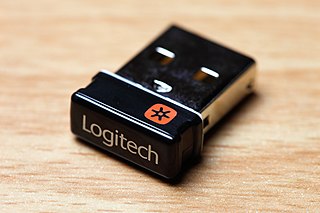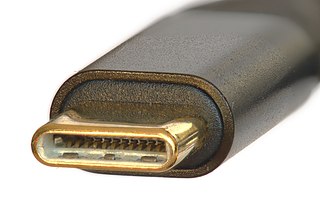Related Research Articles

Universal Serial Bus (USB) is an industry standard, developed by USB Implementers Forum (USB-IF), that allows data exchange and delivery of power between many types of electronics. It specifies its architecture, in particular its physical interface, and communication protocols for data transfer and power delivery to and from hosts, such as personal computers, to and from peripheral devices, e.g. displays, keyboards, and mass storage devices, and to and from intermediate hubs, which multiply the number of a host's ports.

A webcam is a video camera which is designed to record or stream to a computer or computer network. They are primarily used in video telephony, live streaming and social media, and security. Webcams can be built-in computer hardware or peripheral devices, and are commonly connected to a device using USB or wireless protocol.

High-Definition Multimedia Interface (HDMI) is a proprietary audio/video interface for transmitting uncompressed video data and compressed or uncompressed digital audio data from an HDMI-compliant source device, such as a display controller, to a compatible computer monitor, video projector, digital television, or digital audio device. HDMI is a digital replacement for analog video standards.
QuickCam is a line of webcam video camera products originally produced by Connectix in 1994 and acquired by Logitech in 1998. Although its picture quality would today be considered primitive, it was the first widespread used webcam-like device.

Windows Movie Maker is a discontinued video editing software program by Microsoft. It was first included in Windows Me on September 14, 2000, and in Windows XP on October 25, 2001. It later became a part of the Windows Essentials software suite, and offered the ability to create and edit videos as well as to publish them on OneDrive, Facebook, Vimeo, YouTube, Windows Live Groups, and Flickr. It is comparable to Apple's iMovie.

Device Manager is a component of the Microsoft Windows operating system. It allows users to view and control the hardware attached to the computer. When a piece of hardware is not working, the offending hardware is highlighted for the user to deal with. The list of hardware can be sorted by various criteria.

Xbox Live Vision is a webcam accessory that was developed as an accessory for the Xbox 360 video game console. It was announced at E3 2006 and was released in North America on September 19, 2006, Europe and Asia on October 2, 2006, and Japan on November 2, 2006.
Various accessories for the PlayStation 3 video game console have been produced by Sony and third-party companies. These include controllers, audio and video input devices like microphones, video cameras, and cables for better sound and picture quality.
The USB video device class is a USB device class that describes devices capable of streaming video like webcams, digital camcorders, transcoders, analog video converters and still-image cameras.
The Archos Generation 6 (Gen6) product series is represented by misc "Internet Media Tablets" or "IMT", e.g. the Archos 5 Internet Media Tablet This series of tablet computers developed by the French company Archos that features a resistive touchscreen for video, photo, audio, internet browsing and other multimedia applications. The individual numbering of the distinct models seems up to now to roughly resemble the length of the display diagonal in inches.

IEEE 1394 is an interface standard for a serial bus for high-speed communications and isochronous real-time data transfer. It was developed in the late 1980s and early 1990s by Apple in cooperation with a number of companies, primarily Sony and Panasonic. It is most commonly known by the name FireWire (Apple), though other brand names exist such as i.LINK (Sony), and Lynx.

The Razer Switchblade was a concept design of a portable gaming device developed by Razer. It was first unveiled on January 5, 2011 at the Consumer Electronics Show (CES). The Switchblade won The Best of CES 2011 People's Voice award.

Wireless Display (WiDi) is technology developed by Intel that enables users to stream music, movies, photos, videos and apps without cables from a compatible computer to a compatible HDTV or through the use of an adapter with other HDTVs or computer monitors. Intel WiDi supports HD 1080p video quality, 5.1 surround sound, and low latency for interacting with applications sent to the TV from a PC running Windows 7 or later.
Various accessories for the PlayStation 2 video game console have been produced by Sony, as well as third parties. These include controllers, audio and video input devices such as microphones and video cameras, and cables for better sound and picture quality.

The Logitech Unifying Receiver is a small dedicated USB wireless receiver, based on the nRF24L-family of RF devices, that allows up to six compatible Logitech human interface devices to be linked to the same computer using 2.4 GHz band radio communication. Receivers that are bundled with a Logitech product are paired with the device at the factory. When purchasing a replacement receiver or connecting multiple devices to one receiver, pairing requires the free-of-charge Logitech Unifying software, available for Microsoft Windows and macOS. On Linux, the Solaar software can be used to adjust the configurations. Although not compatible with Bluetooth, devices pair to Unifying Receivers in a similar way. Peripherals remain paired, and can then be used on systems not supporting the software. Logitech receivers compatible with the Unifying protocol can be identified by the orange Unifying logo, which distinguishes them from Logitech Nano receivers of similar appearance, which pair similarly but only with a single device, without using the Unifying protocol.

The LenovoIdeaPad Flex is a 2-in-1-laptop line by Lenovo. Unlike the Lenovo IdeaPad Yoga line of devices, the keyboard does not bend back entirely to allow use as a tablet, it is only a dual-mode laptop. Its keyboard rotates behind the display in order to put the device into "stand mode." Stand mode brings the user closer to the screen for watching videos and using touch-enabled apps and removes the visual distraction from the keyboard.

USB-C, or USB Type-C, is a 24-pin connector that supersedes previous USB connectors and can carry audio, video, and other data, to connect to monitors or external drives. It can also provide and receive power, to power, e.g., a laptop or a mobile phone. It is used not only by USB technology, but also by other protocols, including Thunderbolt, PCIe, HDMI, DisplayPort, and others. It is extensible to support future protocols.

Guvcview is a webcam application, i.e. software to handle UVC streams, for the Linux desktop, started by Paulo Assis in 2008. The application is written in C and is free and open-source software released under GPL-2.0-or-later.
References
- ↑ "Support | AVerMedia". www.avermedia.com. Retrieved 2017-05-16.
- ↑ "HDV-UH60|USB Converter-Shenzhen HDCVT Technology Co., LTD". www.hdcvt.com. Retrieved 2017-05-16.
- ↑ "Magewell - USB Capture HDMI Gen 2". www.magewell.com. Retrieved 2017-05-16.
- ↑ "Magewell - USB Capture HDMI Gen 2 - Tech Specs". www.magewell.com. Retrieved 2017-05-16.